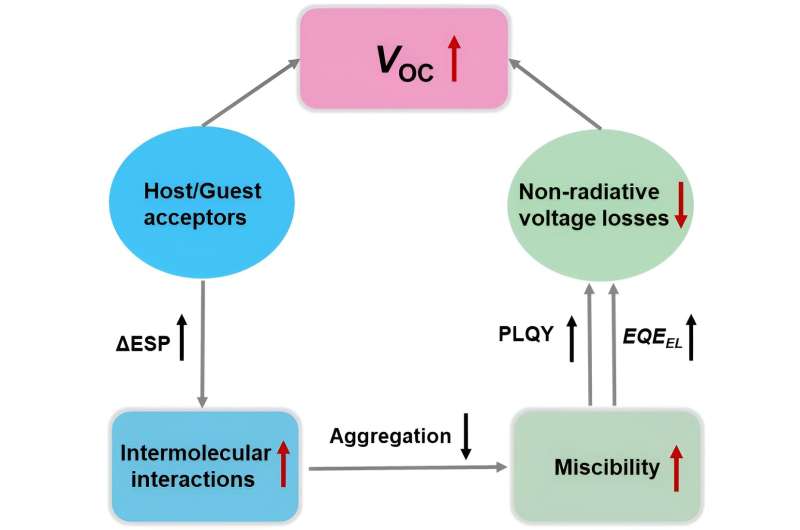
A research group led by Prof. Ge Ziyi at the Ningbo Institute of Materials Technology and Engineering of the Chinese Academy of Sciences has proposed a key strategy for optimizing guest components to minimize non-radiative voltage losses and thus achieve high-efficiency ternary organic solar cells (OSCs).
This work was published in Advanced Materials.
OSCs have attracted considerable attention in the field of organic electronic devices due to their light weight, good mechanical flexibility and transparency. The ternary strategy, in which a guest component is introduced into a host binary system, is considered to be one of the most effective and facile ways to achieve OSCs with excellent power conversion efficiencies (PCEs).
Various efficient guest components have been developed for binary host systems, but there is still no effective way to predict the effectiveness of guest components in improving device efficiency.
Using density functional theory calculations, the researchers designed and synthesized three asymmetrical non-fullerene acceptors (ANFs) with different electrostatic potential (ESP) distributions, namely ANF-1, ANF-2, and ANF-3.
These three ANFs were used as guest acceptors in the well-known host system of D18:N3. Then the effects of the introduction of the guest component on the photovoltaic properties were carefully investigated.
The experimental results showed that a large ESP difference between the guest acceptor and the host system leads to strong intermolecular interactions and a high miscibility of the two molecules, which improves the luminescent efficiency of the blend film and the electroluminescence quantum yield (EQEEL) of the device, thus reducing the voltage loss of ternary OSCs.
Compared with ANF-1 and ANF-2-based ternary films, the ANF-3-based ternary film exhibited a larger ESP difference between the guest acceptor and the host acceptor, thus exhibiting higher and more balanced mobility, and smaller phase separation size, contributing to a more effective charge transport.
As a result, the D18:N3:ANF-3 ternary OSC achieved the highest PCE of 18.93% with a low voltage loss of 0.236 eV.
This work provides an important guideline for designing high-efficiency guest acceptors to further improve the open-circuit voltage in the ternary OSCs: increase the ESP difference between the guest acceptor and the host acceptor.
Furthermore, this rule has been verified in other reported high-efficiency ternary OSCs, demonstrating its excellent generality.
This study may shed light on the design and development of single-junction OSCs with PCE above 20%.
More information: Shuncheng Yang et al, Guest Acceptors with Lower Electrostatic Potential in Ternary Organic Solar Cells for Minimizing Voltage Losses, Advanced Materials (2024). DOI: 10.1002/adma.202401789
Citation: Novel method proposed to design high-efficiency guest components for ternary organic solar cells (2024, April 17) retrieved 17 April 2024 from https://techxplore.com/news/2024-04-method-high-efficiency-guest-components.html
This document is subject to copyright. Apart from any fair dealing for the purpose of private study or research, no part may be reproduced without the written permission. The content is provided for information purposes only.
